A paper delivered at the Collections Trust Annual Conference, Natural History Museum, 22 September 2015.
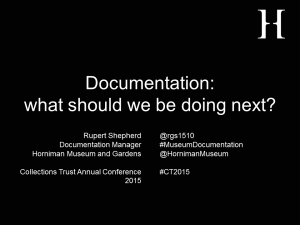
Introduction
I’d like to thank Nick Poole for the very flattering invitation to speak to you today. In fact, Nick asked me to talk about ‘What next for Documentation?’ with the aim of ‘tak[ing] a look at where we are today with documentation, which challenges have been solved and which are still to be addressed.’ But I’m aware that I only have about 20 minutes, and thought it would be more useful to focus on more practical issues. So you’ll see from the programme that I’ve changed the title slightly, to ‘What should we be doing next?’
I plan to very quickly sketch out the current position facing museums, and then ask what role documentation has in helping us meet those challenges. My talk is based on my experience at the Horniman Museum, and I will also say something about how we’re addressing the problems I’ve identified. Whilst I’m sure the details differ, I think the Horniman’s experience is broadly similar to many other museums’, and I hope that my proposals will be useful across the sector.
For those of you who don’t know us, the Horniman Museum and Gardens is a surprising, eccentric, family-friendly attraction in Forest Hill in south east London.

It has been open since the late nineteenth century, when the tea trader and philanthropist Frederick John Horniman first opened his house and extraordinary collection of objects to the local community. Since then, our collection has grown significantly and includes internationally important collections of anthropology and musical instruments, as well as an acclaimed aquarium and natural history gallery – all surrounded by 16 acres of beautiful Gardens offering breathtaking views across London.
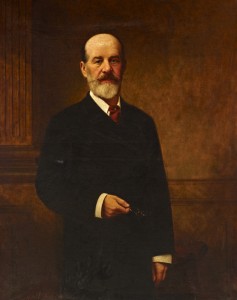
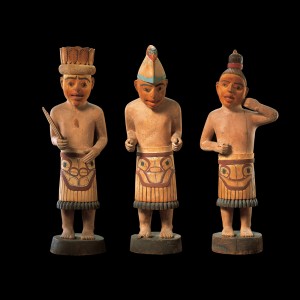
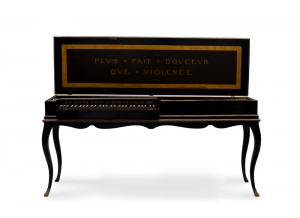

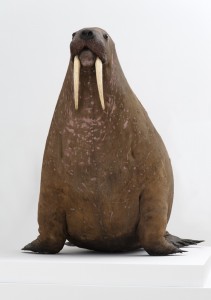
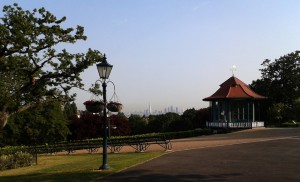
We are a non-departmental public body, which means that we are not a national museum, but are primarily funded by Grant In Aid from the Department for Culture, Media and Sport (DCMS). In 2014–15, our annual budget was £6.6 million, and we had a full-time equivalent staff of 126 (of whom 24 were working on projects), and about a third of a million objects. We aim to use our worldwide collections and the Gardens to encourage a wider appreciation of the world, its peoples and their cultures, and its environments.
The current position
The position
What position are museums in today? In a word: bad. If we only look at the Museums Association’s annual cuts survey, which has been running since 2011,1 at least half the respondents in three years out of four reported a reduction in their income.
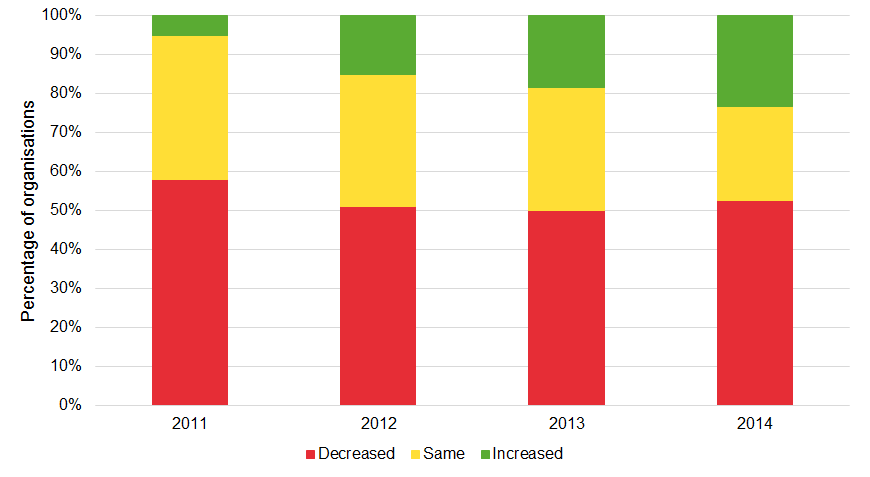
At least a third, and in two years more than half, of respondents reported a reduction in the number of paid staff.
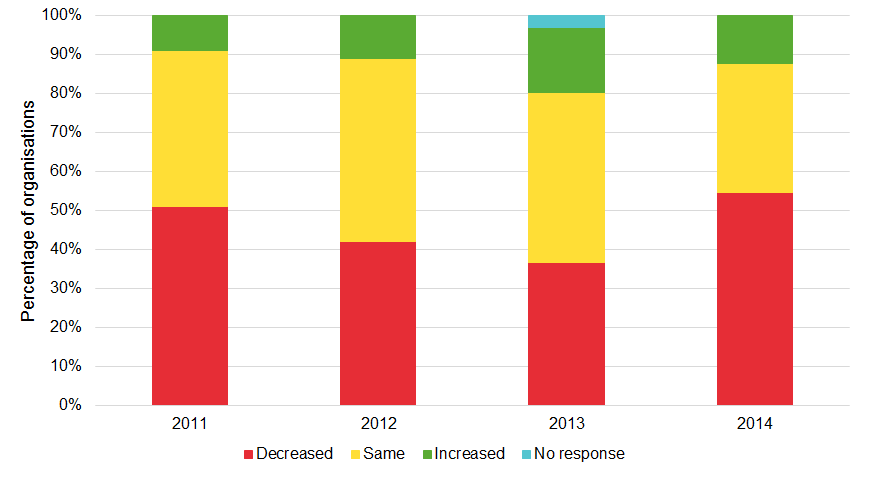
Between 11 and 22 percent of museums each year reduced their opening hours, and between 7 and 22 percent reported partial or total closures.
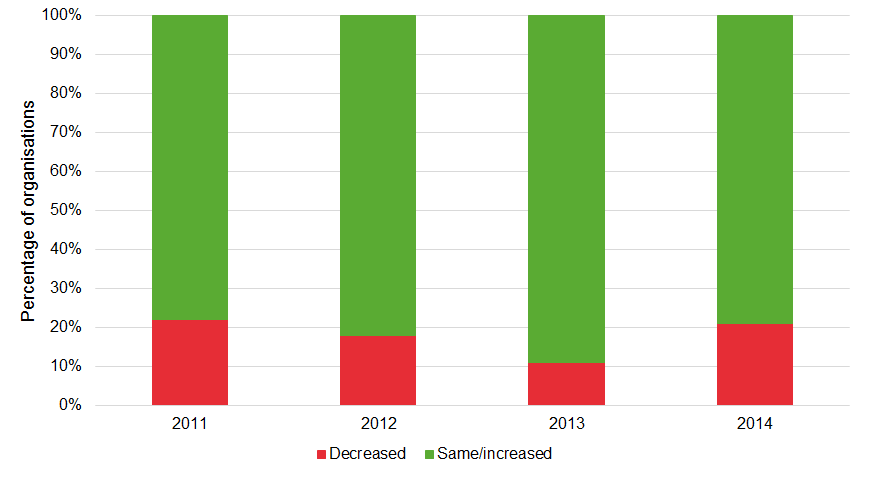
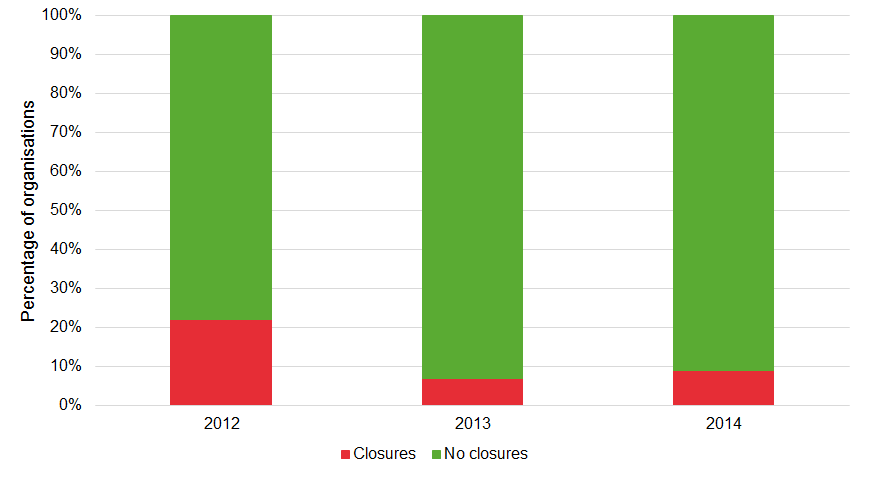
This may not look like much on a graph, but the Museums Association’s map of museum closures since 2005 is chilling.
At the Horniman, we have been lucky, but the picture is still worrying: our income from Grant In Aid is the same as it was eight years ago, and we are making up more and more of the shortfall from earned income: for example, we now charge for temporary exhibitions and for admission to our Aquarium, but more importantly we have been making increasing sums from our café, shop, and commercial hire for weddings, filming and so on. And a greater and greater proportion of our new initiatives, projects, and public programmes have been funded by grants and donations, including the Renaissance and Major Partner programmes, and our current HLF Stage 1 grant to redisplay our anthropology galleries.
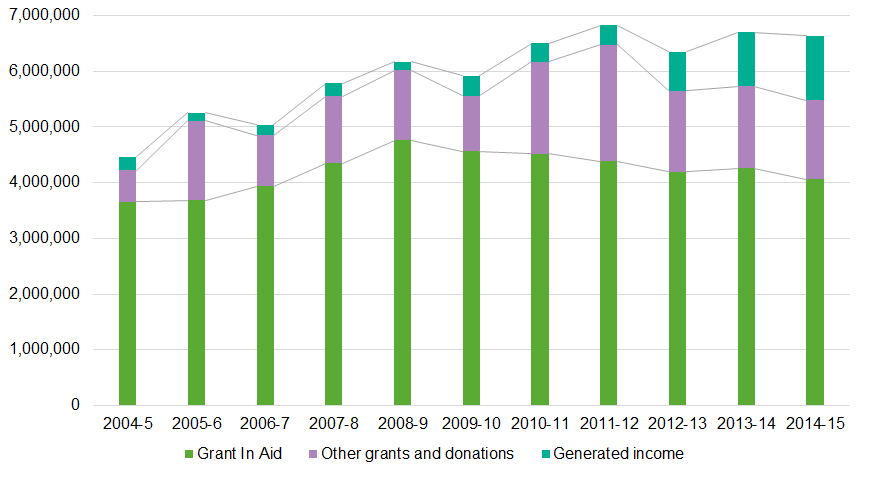
And things are not going to get better. The DCMS, which funds national museums, certain non-nationals like the Horniman, and Arts Council England (ACE), has been asked to model cuts of 25% and 40% over the next five years, ahead of this November’s comprehensive spending review. The same is true of the Department for Communities and Local Government, which provides a significant amount of local government funding.2
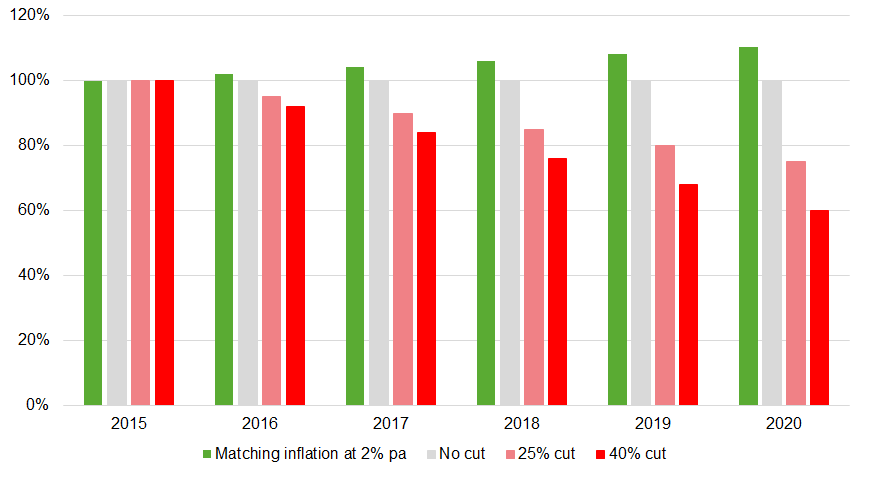
The challenge
So museums have been, and will continue to be, asked to continue to work effectively with fewer and fewer resources.
Now, we are judged on the quality of what we do. All things being equal, quality depends upon the resource available, and that resource comprises two aspects, money and time: money pays for people to work for a certain time. If money is reduced, the time is also reduced; so is the resource available and, as a result, the quality of the output. But we don’t want to reduce the quality. It’s unlikely we’ll be given more money; so we need to find a way of increasing the time available to work on the things that matter. In other words: we need to work more efficiently.
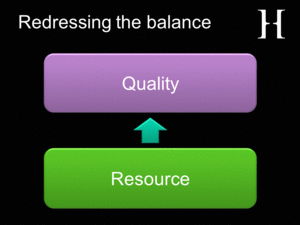
How can documentation help us meet the challenge?
This is where I believe documentation can help us meet the challenge. There has been a great deal of talk recently of ‘resilience’, of putting museums in a better position to face the future. From what I have seen of it, this has focussed on governance and funding. But this is only part of the picture, and I hope I will show that improving documentation, along with other back-office work, is just as crucial to ensuring museums’ long-term resilience.
First, I don’t think you’d be here if you didn’t know what documentation was, but just to be certain, here is CIDOC’s definition:
Museum documentation is concerned with the development and use of information about the objects within a museum collection and the procedures which support the management of the collection.3
So, how does this help us work efficiently?
Procedures
Alex Dawson has already reminded us about Spectrum, which embodies and standardises the procedures needed to manage a museum and its objects effectively. I don’t have the time to discuss in detail how implementing Spectrum will help you work more efficiently, but let me give you a couple of quick examples:
At the Horniman, curators currently prepare acquisition proposals in Word documents. Once the acquisition has been approved, documentation staff then copy the object descriptions into the database. It’s only cutting and pasting, but when you’re acquiring 268 Japanese toys, or 103 items related to the Iban people of Sarawak, even this takes time. Streamlining and reviewing our procedure to bring it closer to Spectrum would save us time.

Did anyone else wonder how much time dealing with the press (never mind adverse publicity) might have been saved if the Combined Military Services Museum had had more robust acquisition, and deaccession and disposal, procedures in place?4 (I’m delighted to hear that, according to the Museums Journal, they are now reviewing their procedures.5)
So, the first way we can create more time for ourselves is by ensuring that our procedures waste as little time as possible, and have been properly implemented for all our objects – particularly if we follow Nick Merriman’s advice and start collecting again (and Samantha Howes and Anna Ruchalska have shown us how it’s important to think through your procedures in precisely this context).
Data
Behind the procedures are the data. I once asked a senior curator in another museum how he searched for objects made of copper alloy in his museum’s database, and he said that he ran searches for CuA, Cu a, Cu alloy, Copper alloy and bronze, and assembled his list of objects by hand from the results of those searches.
If the data had been consistent and well-organised, he need only have run one search – say, for ‘copper alloy’ – and used those results directly, secure in the knowledge that he had found all objects made of copper alloy, and none that were not. He’d also have saved himself a good ten or fifteen minutes, and he wouldn’t have had to update his manual list every time the database was updated with a new object made of copper alloy.
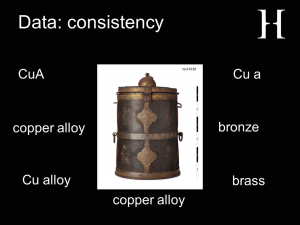
Now, good data requires good authority files: those lists of the correct names to use for people, places, objects, materials, etc. Like our copper alloy, every entity should have one preferred name, and one entry in the authority file. This is causing us particular problems at the Horniman: at one point, there were ten different entries for one of our most important directors, Otto Samson, and object and activity records might have been linked to any one of these, making it impossible to see at a glance which objects were directly related to him, or to know in which authority record we should look for authoritative data about him.
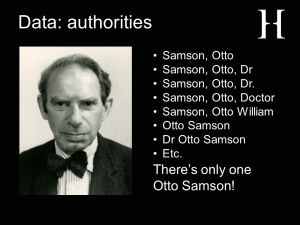
Any defect in data leads to wasted time and lost opportunities as we try to work with our collections. A search in your database should return all the results you are looking for, and no others. Anything which doesn’t is wasting your museum’s time.
What can we do?
Public admission
Before I describe how we can make things better, I’d like to point out that there are good reasons why we may find ourselves with data which is not as immaculate as it should be. For example, at the Horniman, our database is based upon eleven different sources – and that’s ignoring the differences in type and format of documentation between our three curatorial departments:
- Richard Quick’s list of objects
- Receipt scrapbooks
- Accession registers
- Index cards (pre-1947)
- Catalogue cards (post-1947)
- Location cards
- Geographical area lists
- Musical instrument catalogue sheets
- Musical instrument box lists
- History files
- Typological files
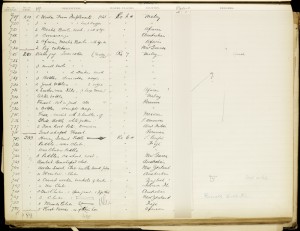

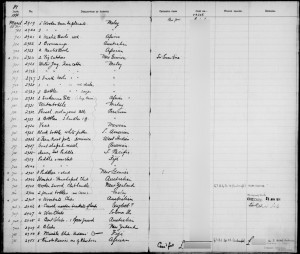
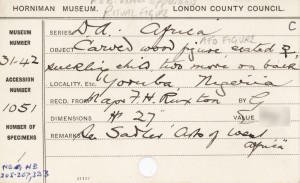
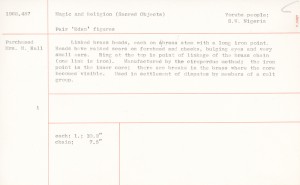
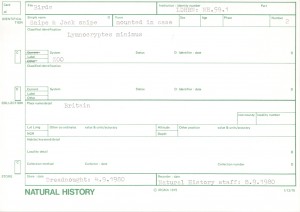
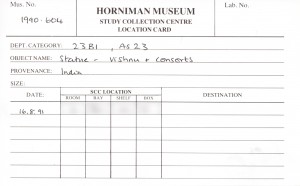
And we used five different databases before 2000, when we acquired MultiMimsy, which has evolved into the Mimsy XG system that we use today:
- Smart II
- dBase III
- Oracle
- Access
- Snap!

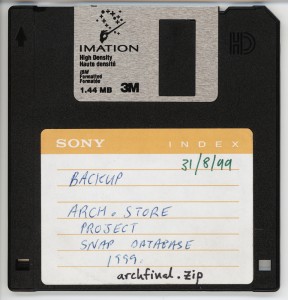
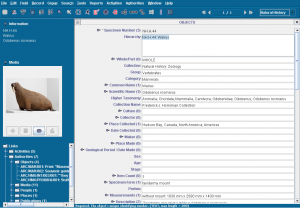
Every stage of this complex evolution has allowed inaccuracies to creep in (in the manual conversions), and kludges to be made when importing or transferring data (in digital systems) in order to get something up and running in a reasonable time, usually with restricted resources. We always promise ourselves that we will come back to it and tidy it up; and then something else comes up, the opportunity has gone, and we have – a backlog of data tidying.
The Horniman is not alone in having such a complicated documentation history: for example, in 1982, the Cuming Museum published a list of the various overlapping but never comprehensive manual sources for their collections:
- Richard Cuming’s MS catalogue, 1840/41–1854 (unnumbered)
- MS inventories of 1906, 1911, 1911/12 & 1918 (unnumbered)
- Typed inventory, 1924–5 & 1926–30 (numbered)
- Accession registers, 1906–58 (part burnt in 1941)
- Miscellaneous indexes, 1920–306
And Seb Chan made a similar point about problems caused by previous documentation only last month, when he explained why it’s difficult to give a clear statement about the copyright position of so much of the Cooper Hewitt Museum’s collection:
The majority of the Cooper Hewitt collection predates its acquisition by the Smithsonian. The collection was originally at Cooper Union until the museum there closed in 1963. It was officially acquired by the Smithsonian in 1968 and the Cooper Hewitt was opened in the Andrew Carnegie Mansion in 1976. The effect of this history is that much of the pre-1968 collection is unevenly documented and its provenance very much still under active research. Post-1976 it is possible to see, in the metadata, the different waves of museum management and collection documentation, as new objects were added to the collection and new collection policies became formalised. Being a ‘new museum’ in 1976 also meant that much of the focus was on exhibitions, not so much on the business of documenting collections. Add to this the rise of computer-based catalogues and you have a very ‘layered’ history.7
I suspect this is widespread. Who here would claim that all their collection database is 100% correct? But we don’t advertise the fact, even though it’s not a sign of a poorly-run organisation, it’s simply a fact of life for the great majority of collections of any age. The first thing we can do is start admitting publicly to the drawbacks in our current documentation. This will put us in a better position when we start arguing that we need to address them.
So: I’m Rupert, I work at the Horniman Museum, and my data is not good. Here’s a summary of the state of the Horniman’s authority data that I prepared recently, and you can see the extent of the challenge that faces us:
Fine-tune procedures
The next thing we can do is fine-tune our procedures so that they’re as efficient as possible: nothing slips through the gaps, information doesn’t have to be entered twice, we know the status of each of our objects, and so on. I’m thinking in part of the sort of work Mark Pajak told us about, but fine-tuning could just as easily result in no more than a new set of guidelines.
At the Horniman, we’ve just carried out a superficial review of our current procedures prior to submitting our reaccreditation application last April. We’re following this with a rolling programme of reviews of our core and critical procedures. For example, over the next few months we’ll be looking at our pre-entry, entry, acquisition and inventory control procedures.
COPE
Then we need to think about how we use our information. Here, the important principle is COPE, Create Once, Publish Everywhere: make sure we’re in a position where we only ever enter a piece of information once, and can reuse it whenever and wherever we need to.
Within our collections management systems, that means making full use of authority entries which can be linked to however many other entities are related to them: for example, linking a record for a person to objects they may have made or collected, cultures they studied, events they took part in, publications they wrote: that single person record can enrich all those other records, and vice versa. This is where the contextual information that comes with Nick Merriman’s structured and rigorous acquisition should be held, if we are to make the most efficient use of it.
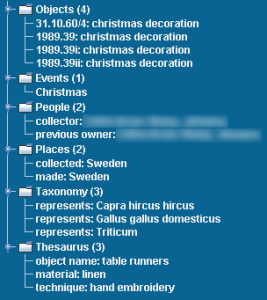
Further afield, this means making sure that the data we have so carefully entered into our collections management systems is used elsewhere: on our websites, obviously, but also in in-gallery interactives and kiosks, other online projects such as Europeana and online research environments, our print materials, display labels – in short, everywhere else.
At the Horniman, I’ve tried to demonstrate how this might work in a small corner of our online collections, dedicated to some of our Antarctic objects. Here, the bulk of the contextual information about the objects is held in our People and Events authorities, and in the object records for the archival items that document their collection and eventual dispersal.
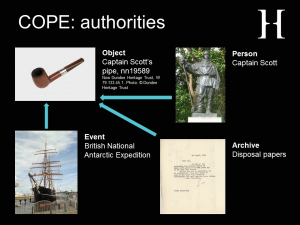
I’ve also made sure that our Mimsy database is not linked directly to our website. Instead, data is extracted into our Collections Information Integration Middleware (CIIM), developed by Knowledge Integration, which allows us to manage and rewrite data without affecting Mimsy, and make it available to multiple consuming applications through a variety of interfaces.
We are therefore also working on sharing our data: in December, we will upload several thousand records to Europeana as part of the Europeana Food and Drink project, and next year we will begin work on uploading our musical instrument records to the National Network and Virtual Interface for UK Musical Instrument Museums.
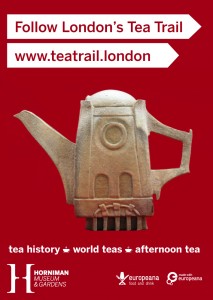
And I’m delighted to announce publicly that the Horniman will be making it as easy as possible to reuse its data by releasing it all under a Creative Commons 0 licence, which has the added advantage of reducing the administration needed to deal with image requests.
Prioritise data tidying
But all this only works if your data is consistent, well-arranged, and accurate.
At the Horniman, we have spent the last few years trying to improve our object data by reviewing in detail 30,000 of our anthropology records as part of our ACE-funded Collections People Stories project. These are some of our achievements:
- 40,015 accession register entries checked against 73,832 Mimsy records
- 32,724 objects processed
- 1,701 star objects identified
- 450 disposal candidates identified
- 51,363 photographs taken and uploaded to Mimsy
- 1,599 duplicate Mimsy records reconciled
- 582 Mimsy records given correct object numbers
- 2,572 expert assessments of objects entered into Mimsy
- 1,716 anthropology archive files listed in Mimsy
But remember that, if we focus on our authorities, this will reduce the quantity of data that needs to be tidied. We will get the most out of any data-tidying we carry out if we
- first make sure our authorities are fit for purpose;
- second, use these to correct the ‘index’ fields that are based upon them, and drive the retrieval and interlinking of data;
- and only then start on the more complex text fields which are unique to every object.
I am currently planning how we can do this at the Horniman – although you’ll recall the extent of the problem. I aim to prioritise quick wins, technical solutions, bulk updates, and changes which prevent things from getting any worse and make the most impact.
Practicalities
So we should consolidate, retrench, and go back to basics. This may sound negative to many of you. But it is not: to misquote Montaigne, we must ‘step back in order to make a better leap forwards’.8
But as we take our steps back, we are faced with a perennial problem: funding; or rather, where funding is directed. My experience has been that museums will nearly always prioritise the public-facing output over the infrastructural improvement. So, the cuts survey shows that an increasing proportion of museums expect to be spending less on collections management activities over the forthcoming year.
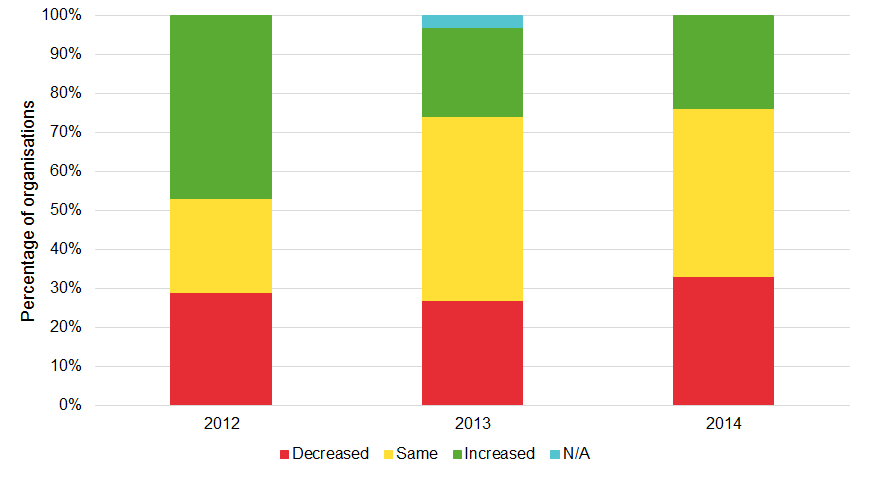
In all this, documentation suffers particularly. I believe this is because our outputs are not in themselves readily visible to our public and our funders, nor is the work we do easy to understand without explanation. This is the problem of what I call the ‘invisibility’ of documentation. Over the last couple of years I’ve been trying to make what we do more visible using the #MuseumDocumentation hashtag. The aim is to say both what we’re doing and, crucially, why we’re doing it, and I would urge you all to contribute.
I propose everyone working in #MuseumDocumentation tweets once a day what they’re doing & why it’s important using this hashtag. Please RT!
— Rupert Shepherd (@rgs1510) December 1, 2013
In passing, one thing that we’ve noticed has increased staff interest in documentation at the Horniman is pictures of the objects. Creating these need not be too difficult: during Collections People Stories, we created a system for documentation and collections assistants to take good reference shots with very basic setups, which we used to photograph over 22,000 objects. Our experience seems to chime with what Mark Pajak was saying about the importance of images to departments right across a museum.
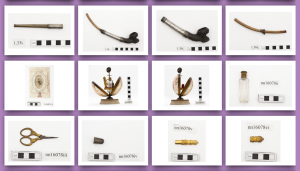
What next?
So, what should we be doing next? I’d like to end with some concrete suggestions for you all:
- Documentalists: go back to your procedures and review them and streamline them; and go back to your data and tidy it, then augment it, focusing on your authorities first.
- Senior managers and directors: support this work, ensure that it is adequately resourced and a priority area for your fundraising teams, and make sure your trustees or governing bodies understand how vital it is.
- Governing bodies and Collections Trust: argue, loudly, that documentation is the backbone of a museum, and crucial to ensuring its resilience.
- Funding bodies: start prioritising and funding projects which enable museums to manage their collections as efficiently as possible. (And ACE, in particular, start putting money aside to fund directly, and as a matter of course, the work laid out in museums’ retrospective documentation plans, which you insist upon for accreditation.)
If we do this, we will end up with museums which can better endure the lean times ahead, and will be poised to flourish when better times return.
Updates
- 22 September 2015: minor tweaks to better reflect text as delivered, including addition of references to other papers at he conference.
- 23 September 2015: COPE authorities slide added following receipt of permission to reproduce.
Notes
- Kathryn Newman and Paul Tourle, The Impact of Cuts on UK Museums, July 2011: A Report for the Museums Association (London: Museums Association, July 2011), http://www.museumsassociation.org/download?id=363804, and Appendix, http://www.museumsassociation.org/download?id=363805; Gina Evans, The Impact of Cuts on UK Museums, July 2012: A Report for the Museums Association (London: Museums Association, July 2012), http://www.museumsassociation.org/download?id=770702; Gina Evans, Cuts Survey 2013 (London: Museums Association), October 2013, http://www.museumsassociation.org/download?id=1019920; Museums Association, Cuts Survey 2014 (London: Museums Association), November 2014, http://www.museumsassociation.org/download?id=1123548; all accessed 27 August 2015. [↩]
- Patrick Steel, ‘Government departments model 40% cuts’, Museums Journal [online], 29 July 2015, http://www.museumsassociation.org/museums-journal/news/29072015-government-departments-model-40-precent-cuts, accessed 27 August 2015. [↩]
- CIDOC, Statement of principles of museum documentation, version 6.2 (s.l.: CIDOC, June 2012), section 1.1, available at http://network.icom.museum/fileadmin/user_upload/minisites/cidoc/DocStandards/principles6_2.pdf). [↩]
- Peter Henn, ‘Woman donates medals to museum … which sells them for PITIFUL £32’, Express [online], 5 August 2015, http://www.express.co.uk/news/uk/596353/Medals-sold-eBay-32-Maldon-Sudbury; Richard Brown, ‘Maldon grandmother vents frustration as father’s war medals she donated to museum are sold on eBay’, Essex Chronicle [online], 5 August 2015, http://www.essexchronicle.co.uk/Museum-sold-father-s-medals-eBay/story-27507894-detail/story.html; Mark Duell, ‘Grandmother donates her Second World War her father’s medals to museum – only for it to flog them for just £32 on eBay’, MailOnline, 5 August 2015, http://www.dailymail.co.uk/news/article-3185869/Grandmother-donates-Second-World-War-hero-father-s-medals-museum-flog-just-32-eBay.html; ‘Suffolk grandmother “disgusted” after medals she donated to museum are sold online’, ITV News, 6 August 2015, http://www.itv.com/news/anglia/update/2015-08-06/suffolk-grandmother-disgusted-after-medals-she-donated-to-museum-are-sold-online/; all accessed 2 September 2015. [↩]
- Rebecca Atkinson, ‘Museum criticised for selling donated medals’, Museums Journal [online], 11 August 2015, http://www.museumsassociation.org/museums-journal/news/11082015-museum-criticised-for-selling-donated-medals, accessed 2 September 2015. [↩]
- GJD, The Cuming Museum Records (1782 to 1958): The Difference Between a Collection and a Museum, London Borough of Southwark Cuming Museum Information Leaflet no. 12 (London: Cuming Museum, March 1982). [↩]
- Seb Chan, ‘Slowly improving copyright clarity’, Cooper Hewitt Labs [online], 24 August 2015, http://labs.cooperhewitt.org/2015/slowly-improving-copyright-clarity/, accessed 2 September 2015 (my emphasis). [↩]
- ‘Reculer pour mieux sauter.’ Criticising the younger Pliny and Cicero, who withdrew from the world only in order to increase their fame, Montaigne in fact wrote ‘They step back only to make a better jump, and, with greater force, to make a lively charge through the troops of men.’ Michel de Montaigne, The Complete Essays, ed. & tr. M. A. Screech (Harmondsworth: Penguin, 1991), p. 277; the original text can be found online at http://artflsrv02.uchicago.edu/cgi-bin/philologic/getobject.pl?c.0:2:39.montaigne.751302.751307.751313, accessed 20 August 2015. [↩]
